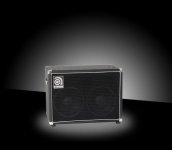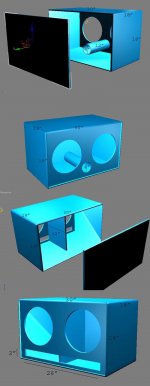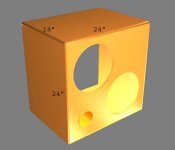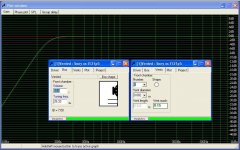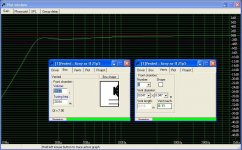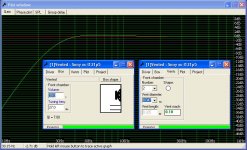Re Sub
Well yes you could buy another Sony Sub if money is the problem and run the 2 subwoofers. I dont' know anything about this unit but if it is a 4 ohm unit then you should run them in series. This will give you an 8 ohm impedance and while it wont be as loud as if you ran them in parallel (2 ohms) they will last longer because they will only be given half the power (remember sub-woofers aren't really designed for bass guitar.
Build a box something like the picture and build it as large as you are happy to carry around (it will be very heavy), just make it strong and use composite wood (particleboard or MDF 18mm+ thick). Once you have built the box you can either leave it sealed (safer and smoother bottom end response) or you can port it to give more efficiency (louder) at the bottom end.
If you can find the T/S parameters it could help you to build the right box, but don't worry too much because the box can still be "tuned".
I have built things before on a budget and you will be surprised at what can be achieved and how good it will sound.
Cheers
Well yes you could buy another Sony Sub if money is the problem and run the 2 subwoofers. I dont' know anything about this unit but if it is a 4 ohm unit then you should run them in series. This will give you an 8 ohm impedance and while it wont be as loud as if you ran them in parallel (2 ohms) they will last longer because they will only be given half the power (remember sub-woofers aren't really designed for bass guitar.
Build a box something like the picture and build it as large as you are happy to carry around (it will be very heavy), just make it strong and use composite wood (particleboard or MDF 18mm+ thick). Once you have built the box you can either leave it sealed (safer and smoother bottom end response) or you can port it to give more efficiency (louder) at the bottom end.
If you can find the T/S parameters it could help you to build the right box, but don't worry too much because the box can still be "tuned".
I have built things before on a budget and you will be surprised at what can be achieved and how good it will sound.
Cheers
Attachments
Sorry Ahmad_tbp
I was typing when you sent the last message. Good luck with the small box. Remember bigger is better (up to a point that is).
Cheers
I was typing when you sent the last message. Good luck with the small box. Remember bigger is better (up to a point that is).
Cheers
hi quasi .. i donno how should i thank u ...
u help me too much man 😉 .. thnx a lot 😉 ...
sorry i have another question ,, it s beacuse of my english 😛 ..
i cant understand what do u mean 😛 .. what is "port" mean here ?
or not ,, what does that hole doin ? .. & how size should it be for my 2*12" subs cabinet ? .. 😛
i ll send my design for 2*12" cabinet soon 😉 ... & i ll build it w a thick mdf 😉 ,,,
i really reaaalllyyy donnno know how should i thank u man ...
Cheers quasi 😉
u help me too much man 😉 .. thnx a lot 😉 ...
sorry i have another question ,, it s beacuse of my english 😛 ..
i cant understand what do u mean 😛 .. what is "port" mean here ?
i saw loudspeakers cabinets ( specialy subwoofers ) have a hole in them ... i donno what is it doin .. & i donno if u mean that by "port" ... is it the port u said ? 😛 .....or you can port it to give more efficiency (louder) at the bottom end....
or not ,, what does that hole doin ? .. & how size should it be for my 2*12" subs cabinet ? .. 😛
i ll send my design for 2*12" cabinet soon 😉 ... & i ll build it w a thick mdf 😉 ,,,
i really reaaalllyyy donnno know how should i thank u man ...
Cheers quasi 😉
i desgined too diffrent cabinet ...both are 18"*30"*18" ...
first one w one (or two) 4" hole & a 12"pipe !!! lol .. i just draw it cuz i saw this hole in most cabinets 😛 .. i have no idea bout this hole & pipe dimensions .. or what does it doin 😛 ...
the second draw , is a same cabinet but i divisioned the inner space by a 12" wall .. & put a 26"*2" hole at the bottom of the cabinet ... ( just like some cabinets i saw ) lol .. as i told i have no idea bout this hole too .. !!!!!!! lol
i just put these there as i saw in some cobinets ... any idea ?
is this box enough ? or i need a bigger one ? ...
and is this hole is nessecary ? or better if i make front panel seald ?
or if this holes are good which design is better ? . the cabinet w one(or two) hole in it or the cabinet as my second design ? ..
and plzz with which dimensions is good for them ? 😛
thank u so much ...
( i m busy with my test box 🙂 )
first one w one (or two) 4" hole & a 12"pipe !!! lol .. i just draw it cuz i saw this hole in most cabinets 😛 .. i have no idea bout this hole & pipe dimensions .. or what does it doin 😛 ...
the second draw , is a same cabinet but i divisioned the inner space by a 12" wall .. & put a 26"*2" hole at the bottom of the cabinet ... ( just like some cabinets i saw ) lol .. as i told i have no idea bout this hole too .. !!!!!!! lol
i just put these there as i saw in some cobinets ... any idea ?
is this box enough ? or i need a bigger one ? ...
and is this hole is nessecary ? or better if i make front panel seald ?
or if this holes are good which design is better ? . the cabinet w one(or two) hole in it or the cabinet as my second design ? ..
and plzz with which dimensions is good for them ? 😛
thank u so much ...
( i m busy with my test box 🙂 )
Attachments
First, you should try a box with no hole. If you think the low frequencies are not loud enough, then you can make a hole. In that hole, you put a pipe. Longer is the pipe, lower the box will be tuned.
Remember to seal well your box, no air should come out of anywhere except air moved by the speakers. If you put a pipe in it, seal it tightly in the hole, the air should be only coming from inside the pipe.
If you go with the pipe, try a 3 inch diameter pipe first. If the pipe is making too much air noise, get a 4 inch diameter pipe. Remember that if you go with a larger diameter, you need to make it longer to tune at the same frequency.
Remember to seal well your box, no air should come out of anywhere except air moved by the speakers. If you put a pipe in it, seal it tightly in the hole, the air should be only coming from inside the pipe.
If you go with the pipe, try a 3 inch diameter pipe first. If the pipe is making too much air noise, get a 4 inch diameter pipe. Remember that if you go with a larger diameter, you need to make it longer to tune at the same frequency.
hi simon5
i wanna order this box to a carpenter , i dont want to build it my self ... so it s maybe better if i order it w a 4"hole and ( or may be two holes ,, what do u think ? 🙁 ) and for the first try seal the hole ( or holes ! ) lol ,, and then if i see the freq is not good open the holes ,,, do u think it s may be better ? ...
and what do u think ? one hole is enough or i should design the box w 2 holes ?
i draw another cabinet ,,, plzz take a look at it ...
it s so much bigger ... thnx a lot
so u think its better if i build a sealed box first ..First, you should try a box with no hole. If you think the low frequencies are not loud enough, then you can make a hole. In that hole, you put a pipe. Longer is the pipe, lower the box will be tuned.
i wanna order this box to a carpenter , i dont want to build it my self ... so it s maybe better if i order it w a 4"hole and ( or may be two holes ,, what do u think ? 🙁 ) and for the first try seal the hole ( or holes ! ) lol ,, and then if i see the freq is not good open the holes ,,, do u think it s may be better ? ...
and what do u think ? one hole is enough or i should design the box w 2 holes ?
i draw another cabinet ,,, plzz take a look at it ...
it s so much bigger ... thnx a lot
Attachments
Yes you could order it with a 4" hole and seal it, then test the box, then put a pipe into it and test it again.
I suggest only one hole since these Sony subwoofer drivers are not moving that much air. Two holes need pipes alot longer to tune it at the same frequency.
The bigger your cab can be, the best it will be with a bass guitar. But it's harder to move hehe!
You could start with a 14 inches long port, then cut it inches by inches to see where you like the sound.
14 inches would tune this box around 20-25 Hz, then you can choose the tuning between 20-25 Hz up to 45-50 Hz with no pipe, only a hole. To tune around 30-35 Hz, you need a 6 inch long pipe, and so on.
If you knew the T/S parameters or know someone would could give them to you, it would be way easier for us to help you! 😉
I suggest only one hole since these Sony subwoofer drivers are not moving that much air. Two holes need pipes alot longer to tune it at the same frequency.
The bigger your cab can be, the best it will be with a bass guitar. But it's harder to move hehe!
You could start with a 14 inches long port, then cut it inches by inches to see where you like the sound.
14 inches would tune this box around 20-25 Hz, then you can choose the tuning between 20-25 Hz up to 45-50 Hz with no pipe, only a hole. To tune around 30-35 Hz, you need a 6 inch long pipe, and so on.
If you knew the T/S parameters or know someone would could give them to you, it would be way easier for us to help you! 😉
hi simon5 😉 ...
i found this things 😛 ... it s in another language i donno what does it means 😛 :
T/S:
Impedance (Ohms): 4
D (mm): 250
D (inch): 9.8
Rdc (Ohms): 3.2
Fs (Hz): 26.4
Qts: 0.42
Qes: 0.44
Qms: 5.86
Vas (Lit.) : 55.5
Vas (ft_): 1.96
Mms (g) : 219.0
Lvc (mH) : 1.2
Xmax (mm) : 7.5
Xmax (inch) : 0.3
BL (Tm) : 16.1
..................................................
Impedance (Ohms) - znamionowy opor glosnika
D (mm) - srednica w jednostce metrycznej
D (inch) - to samo, tyle ze w calach
Rdc (Ohms) - impedancja cewki
Fs (Hz) - czestotliwosc rezonansowa glosnika (punkt najwyzszej impedancji na wykresie zaleznosci impedancji od czestotliwosci)
Qts - dobroc calkowita
Qes - dobroc elektryczna
Qms - dobroc mechaniczna
Vas (Lit.) - objetosc ekwiwalentna w litrach
Vas (ft_) - to samo, ale w stopach szesciennych
Mms (g) - masa ukladu drgajacego (membrana, cewka, zawieszenia chyba obydwa(?) )
Lvc (mH) - indukcyjnosc cewki
Xmax (mm) - maksymalne wychylenie membrany z pozycji rownowagi, po przekroczeniu ktorego zaczna siê znieksztalcenia w dzwieku
Xmax (inch) - to samo - w calach
BL (Tm) - sila napedu magnetycznego
.....................................................
Description:
12" Polypropylene Cone
1200W max input power (350W RMS)
Unique cone design offers superior rigidity
Gold-plated Binding Posts
Small sealed/ported enclosure optimized
4 Ohm Voice Coil
Specification --
Sensitivity -- 89 dB/W/m
Frequency Response -- 18 - 2,000 Hz
Mounting Dimensions --
Diameter -- 277 mm (11")
Depth -- 161 mm (6-3/8")
Weight -- Approx. 5.7 kg (12 lb 10 oz) per speaker
Gold-plated binding posts -- A solid, secure, simple and capable method of transferring serious current to speakers with protection against corrosion for lower resistance.
Polypropylene cone -- A plastic based material used primarily for speaker cones due to its resistance against harsh environmental conditions, rigidity, and damping.
4-layer edge-wound voice coil -- Start with an aluminum former and wind four layers of copper wire that's flat, rather than round. This allows the wire to pack together in a smaller space than would otherwise be needed.
Dual "Triple-layer" damper -- Three layers of high strength damper material make up each of the two spiders, ensuring virtually perfect linear travel of the voice coil. The lead wires are embedded in the top spider, preventing entanglement and extending the voice coil's throw.
Pentagonal Cone -- Improves cone rigidity for lower distortion, and reduction of standing waves on the cone itself, for cleaner sound and better transient response
i found this things 😛 ... it s in another language i donno what does it means 😛 :
T/S:
Impedance (Ohms): 4
D (mm): 250
D (inch): 9.8
Rdc (Ohms): 3.2
Fs (Hz): 26.4
Qts: 0.42
Qes: 0.44
Qms: 5.86
Vas (Lit.) : 55.5
Vas (ft_): 1.96
Mms (g) : 219.0
Lvc (mH) : 1.2
Xmax (mm) : 7.5
Xmax (inch) : 0.3
BL (Tm) : 16.1
..................................................
Impedance (Ohms) - znamionowy opor glosnika
D (mm) - srednica w jednostce metrycznej
D (inch) - to samo, tyle ze w calach
Rdc (Ohms) - impedancja cewki
Fs (Hz) - czestotliwosc rezonansowa glosnika (punkt najwyzszej impedancji na wykresie zaleznosci impedancji od czestotliwosci)
Qts - dobroc calkowita
Qes - dobroc elektryczna
Qms - dobroc mechaniczna
Vas (Lit.) - objetosc ekwiwalentna w litrach
Vas (ft_) - to samo, ale w stopach szesciennych
Mms (g) - masa ukladu drgajacego (membrana, cewka, zawieszenia chyba obydwa(?) )
Lvc (mH) - indukcyjnosc cewki
Xmax (mm) - maksymalne wychylenie membrany z pozycji rownowagi, po przekroczeniu ktorego zaczna siê znieksztalcenia w dzwieku
Xmax (inch) - to samo - w calach
BL (Tm) - sila napedu magnetycznego
.....................................................
Description:
12" Polypropylene Cone
1200W max input power (350W RMS)
Unique cone design offers superior rigidity
Gold-plated Binding Posts
Small sealed/ported enclosure optimized
4 Ohm Voice Coil
Specification --
Sensitivity -- 89 dB/W/m
Frequency Response -- 18 - 2,000 Hz
Mounting Dimensions --
Diameter -- 277 mm (11")
Depth -- 161 mm (6-3/8")
Weight -- Approx. 5.7 kg (12 lb 10 oz) per speaker
Gold-plated binding posts -- A solid, secure, simple and capable method of transferring serious current to speakers with protection against corrosion for lower resistance.
Polypropylene cone -- A plastic based material used primarily for speaker cones due to its resistance against harsh environmental conditions, rigidity, and damping.
4-layer edge-wound voice coil -- Start with an aluminum former and wind four layers of copper wire that's flat, rather than round. This allows the wire to pack together in a smaller space than would otherwise be needed.
Dual "Triple-layer" damper -- Three layers of high strength damper material make up each of the two spiders, ensuring virtually perfect linear travel of the voice coil. The lead wires are embedded in the top spider, preventing entanglement and extending the voice coil's throw.
Pentagonal Cone -- Improves cone rigidity for lower distortion, and reduction of standing waves on the cone itself, for cleaner sound and better transient response
These are exactly what we are looking for. The T/S parameters.
These are the T/S parameters of your 12 " sony xs-l121p5 car subwoofer ???
If yes, then we will be able to help you design a good vented box with a pipe.
Edit: Just checked, you found out the parameters, I'll check how it's looking in WinISD...
These are the T/S parameters of your 12 " sony xs-l121p5 car subwoofer ???
If yes, then we will be able to help you design a good vented box with a pipe.
Edit: Just checked, you found out the parameters, I'll check how it's looking in WinISD...
It's looking quite good, I tried a 4 cu.ft internal net volume with a 12" long 4" diameter pipe.
The maximum power you can put into your box for both woofers is 325W RMS, so you'll need a 325W RMS into 8 ohms or a 325W RMS into 2 ohms amplifier.
112 dB on the Low B string and 113 dB on the low E string, very flat frequency response curve. Maximum SPL is 114 dB at higher frequencies.
If your carpenter use 3/4" MDF or 3/4" plywood and he use some bracing in the box, your bass cab will be quite nice for a budget solution, probably beating some commercial bass cabs.
The maximum power you can put into your box for both woofers is 325W RMS, so you'll need a 325W RMS into 8 ohms or a 325W RMS into 2 ohms amplifier.
112 dB on the Low B string and 113 dB on the low E string, very flat frequency response curve. Maximum SPL is 114 dB at higher frequencies.
If your carpenter use 3/4" MDF or 3/4" plywood and he use some bracing in the box, your bass cab will be quite nice for a budget solution, probably beating some commercial bass cabs.
WWWWWWWWWWWWWWOOOOOOOOOOOOOOOOOWWWWWWWWWWWWWWWWWWWWWWWWWWWWWW!!!!!!!!!!!man
thank u so much mannnn 🙂
how should i thank u alllll ???
my test cobinet is near to be finished ... 🙂
i ll inform u 🙂 ...
thank u so much mannnn 🙂
how should i thank u alllll ???
my test cobinet is near to be finished ... 🙂
i ll inform u 🙂 ...
hi simon5 again 😛 ...

...
so u think if i build the 3rd design and use a 4" * 12" pipe it s good yeah ? ...
what is a 4cu.ft internal net volume ? 😛...I tried a 4 cu.ft internal net volume with a 12" long 4" diameter pipe

...
so u think if i build the 3rd design and use a 4" * 12" pipe it s good yeah ? ...
I mean 4 cubic feet internal net volume.
Internal measurements of the box then you remove the volume taken by the two woofers, by the bracing and by the port.
Yes I think if you build the 3rd design, it will be ok.
Internal measurements of the box then you remove the volume taken by the two woofers, by the bracing and by the port.
Yes I think if you build the 3rd design, it will be ok.
hi simon5 🙂 😉 ...
i exactly understand whad did u mean 🙂 ..
thnak u so muchhhh 🙂 ...
............
i ll test my box in bout few hours 🙁 .. i ll inform u 🙁 ...
i exactly understand whad did u mean 🙂 ..
thnak u so muchhhh 🙂 ...
............
i ll test my box in bout few hours 🙁 .. i ll inform u 🙁 ...
hi 🙁
i built a 18*14*11" box for my sub , for testin
w a 2" * 1 " long pipe 🙁 .... the sound is realllly bad 🙁 ..
it has somethin veryyyy bad like reverb , reflection ,, somethin like that 🙁 ...
i donno why ? ... is it may cuz of my amp ? 🙁 ...
i built a 18*14*11" box for my sub , for testin
w a 2" * 1 " long pipe 🙁 .... the sound is realllly bad 🙁 ..
it has somethin veryyyy bad like reverb , reflection ,, somethin like that 🙁 ...
i donno why ? ... is it may cuz of my amp ? 🙁 ...
Your pipe is too short, the box is tuned way too high. Small box need longer pipe.
Try to fill the pipe very tight with a tshirt, socks, polyfill or something and check if the sound is better.
If not, maybe your box is not strong enough, step on your box or put heavy things on the box, then hold the sides with your hands and see if the sound changes.
Good luck
Try to fill the pipe very tight with a tshirt, socks, polyfill or something and check if the sound is better.
If not, maybe your box is not strong enough, step on your box or put heavy things on the box, then hold the sides with your hands and see if the sound changes.
Good luck
Dont worry Ahmad_tbp;
It seems that Simon5 has been helping you quite well. I am sorry I went quiet for a while but I was working on other stuff.
As Simon suggested your port is too short and I also think your box is too small even for only one woofer. Simon's idea of stuffing the box is a good one. This will help to stop echoes inside the box and also make the woofer think it's in a bigger box.
I ran the information you provided through WinISD as Simon did and came up with this.
A box of 63.4 litres (sorry I cant get my head around cubic feet) and a -3db point of around 25Hz. Pretty good.
If you plan to use two woofers then you will need to double the size of the box.
Cheers
It seems that Simon5 has been helping you quite well. I am sorry I went quiet for a while but I was working on other stuff.
As Simon suggested your port is too short and I also think your box is too small even for only one woofer. Simon's idea of stuffing the box is a good one. This will help to stop echoes inside the box and also make the woofer think it's in a bigger box.
I ran the information you provided through WinISD as Simon did and came up with this.
A box of 63.4 litres (sorry I cant get my head around cubic feet) and a -3db point of around 25Hz. Pretty good.
If you plan to use two woofers then you will need to double the size of the box.
Cheers

Attachments
Maybe lower?
If you want your speaker to go lower (I don't know how many Hz the top string of a bass guitar is), then you need a bigger box.
I tried a big box in WinISD and got this. This is only for one speaker. Lower bass usually means a bigger box.
Cheers
If you want your speaker to go lower (I don't know how many Hz the top string of a bass guitar is), then you need a bigger box.
I tried a big box in WinISD and got this. This is only for one speaker. Lower bass usually means a bigger box.
Cheers
Attachments
hi all ,,, hi simon5 , hi quasi 😉 ...
thnx a lot ...
i just came back from university ... i started testing subwoofer again w a very simple 25w tda7265 based amp & i use a sine wave generator program to make the signal ...
here is my result 😛 ..( in same volume )
20 hz : the sound is very very low , & i almost hear nothin 🙁 , but when i turn the bass volum a bit higher the speaker is startin to shaking very bad ...
30 hz : still hear a very low sound
40 hz : the sound get a bit louder ... !
50 hz : louder again !
100 hz : the sound is LOUD !!!
150 hz : the sound get low
200 hz : lower again 🙁 ...
300 hz : lower again 🙁 ...
in 1000 hz the sound is very very very low , almost as the same i started the test in 20 hz ... ( and there s no diffrence if i turn the bass volume all the way up )
in 2000 hz i almost hear nothin 🙁 ...
i donno ... 🙁
so u think it s cuz of my box ,, yeah ? ..
i ll completly seal the box & i ll test it again simon5 & i ll inform u ...
thnx a lot ...
i just came back from university ... i started testing subwoofer again w a very simple 25w tda7265 based amp & i use a sine wave generator program to make the signal ...
here is my result 😛 ..( in same volume )
20 hz : the sound is very very low , & i almost hear nothin 🙁 , but when i turn the bass volum a bit higher the speaker is startin to shaking very bad ...
30 hz : still hear a very low sound
40 hz : the sound get a bit louder ... !
50 hz : louder again !
100 hz : the sound is LOUD !!!
150 hz : the sound get low
200 hz : lower again 🙁 ...
300 hz : lower again 🙁 ...
in 1000 hz the sound is very very very low , almost as the same i started the test in 20 hz ... ( and there s no diffrence if i turn the bass volume all the way up )
in 2000 hz i almost hear nothin 🙁 ...
i donno ... 🙁
so u think it s cuz of my box ,, yeah ? ..
i ll completly seal the box & i ll test it again simon5 & i ll inform u ...
- Status
- Not open for further replies.
- Home
- Loudspeakers
- Subwoofers
- Subwoofer construction help plzz :(
